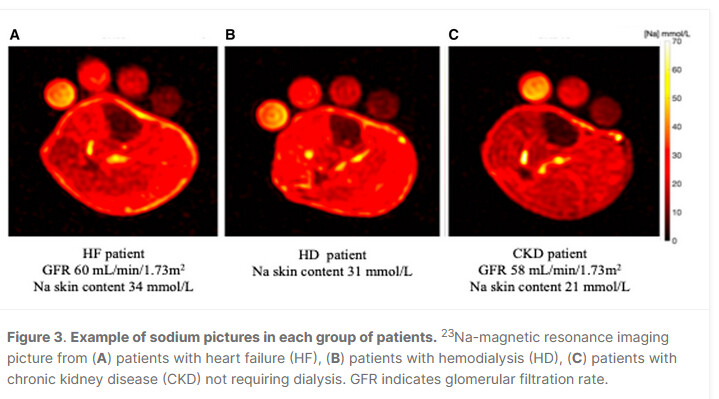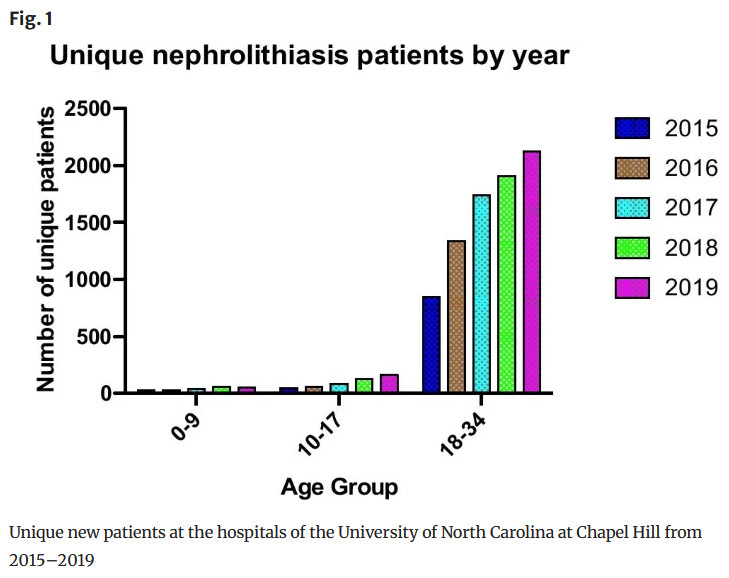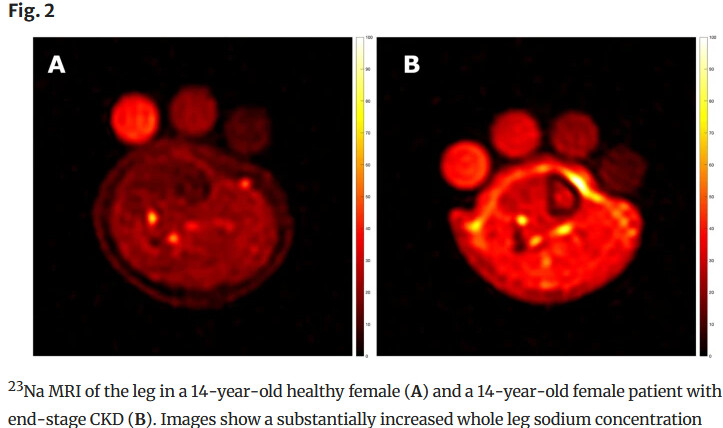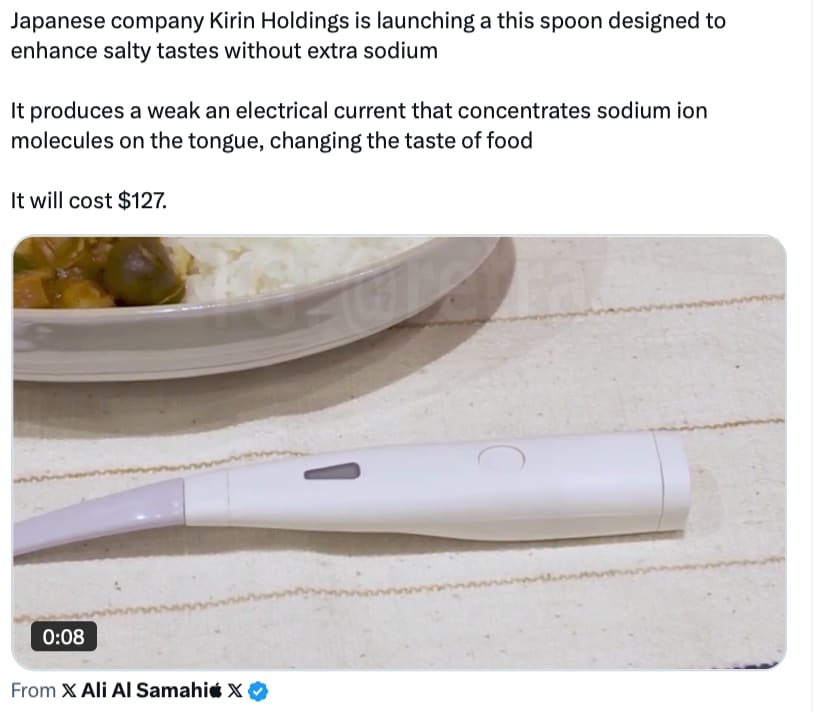I found the write up from the Mars 500 Study Dr. Jens Titze spoke about in the TED talk posted earlier in this thread.
But you shouldn’t wait until you have high blood pressure to think about sodium, said Alta Schutte, a professor of cardiovascular medicine at the George Institute for Global Health in Australia. Excess sodium throughout life can gradually damage blood vessels and eventually lead to high blood pressure. “It’s a cumulative effect,” she said.
Several recent trials have shown that adults with normal blood pressure who cut back on sodium were less likely to develop high blood pressure than those who didn’t reduce their consumption. “Prevention is certainly much better than treatment,” Dr. Hu said.
If it’s cumulative the LEV enthusiasts need to find a way to counter the effects of salt, otherwise it just cumulates year over year and the blood vessels shrivel up. Environmental damage is real. Or am I wrong?
Dr. Joel Furhman called the cumulative effect “salt years” like we describe cigarette smoking in pack years. It seems feasible to me.
I’ve also been wondering (wildly speculating for my own selfish reasons) lately if BSA could impact a person’s salt storage capacity in the skin? I feel like there’s really just so much we still don’t know.
I will say that 9 solid months of really dialing this in has been like getting a good makeover in regards to the appearance of my skin. I also enjoy never waking up with a puffy face. That’s saying a lot for me because I’m the last person to think I look good. Now I’m happy with my appearance even just rolling out of bed in the morning which had stopped happening in my early 40’s. When I did it in 2022 I was eating carnivore and just no longer added salt to my food but still ate things like cheese with high sodium so I got significantly more than I do now. I also didn’t concern myself about salt when traveling or dining out (and paid for it). It still helped but this time around it’s had a much bigger impact. Some of it could be eating more vegetables and fruit of course providing more potassium. My sodium to potassium ratio has been perfect in cronometer for many months.
The incidence of certain autoimmune diseases in our society, including multiple sclerosis and type 1 diabetes, has been rising over recent decades. This research suggests that one factor may be that we now eat more processed foods with high levels of salt.
“It’s premature to say, ‘You shouldn’t eat salt because you’ll get an autoimmune disease.’” Regev says. “We’re putting forth an interesting hypothesis — a connection between salt and autoimmunity — that now must be tested through careful epidemiological studies in humans.”
“Once we have a more nuanced understanding of the development of the pathogenic Th17 cells, we may be able to pursue ways to regulate them or their function,” Kuchroo adds.
Hafler’s group has begun preliminary studies to determine whether restricting salt intake can influence autoimmune disease in people. Hafler says, “I have already begun to suggest to my patients with multiple sclerosis that it may not be bad to restrict their dietary salt intake.”
As reported in the January 20, 2010, online edition of the New England Journal of Medicine, the scientists found that reducing salt intake by 3 grams per day could cut the number of new cases of coronary heart disease each year by as many as 120,000, stroke by 66,000 and heart attack by nearly 100,000. It could also prevent up to 92,000 deaths each year. All segments of the population would benefit, with African-Americans having the greatest improvements overall. Women would particularly benefit from reductions in stroke, older adults from reductions in coronary heart disease and younger adults from lower mortality rates.
Reducing salt intake by 3 grams per day would save the country up to $24 billion in health care costs a year, the researchers estimated. Even a modest reduction of 1 gram per day between 2010 and 2019 would be more cost-effective than using medications to lower blood pressure in people with high blood pressure.
“Our study suggests that the food industry and those who regulate it could contribute substantially to the health of the nation by working toward reducing the amount of salt in the processed foods that all of us consume,” Bibbins-Domingo says.
Normal BP is below 120/80.
Controlling your blood pressure can help prevent or delay serious health problems such as chronic kidney disease, heart attack, heart failure, stroke, and possibly vascular dementia.
It’s so recent knowledge that sodium is stored in bones I could only find a rap video.
In classical physiological teaching, ingested sodium (combined with inadequate excretion) leads to expansion of the extracellular water compartment, congestion, and increasing blood pressure.4 This model is now being augmented with additional appreciation of retained sodium being stored without associated water, within skin, muscle, and bone.
Stored sodium is not biologically inert and can result in a variety of pathophysiological consequences. Preclinical data suggest that sodium may be directly deposited in myocardium and vascular structures leading to tissue remodeling and inflammation. This is independent from the well-described effects of pressure and volume overload.
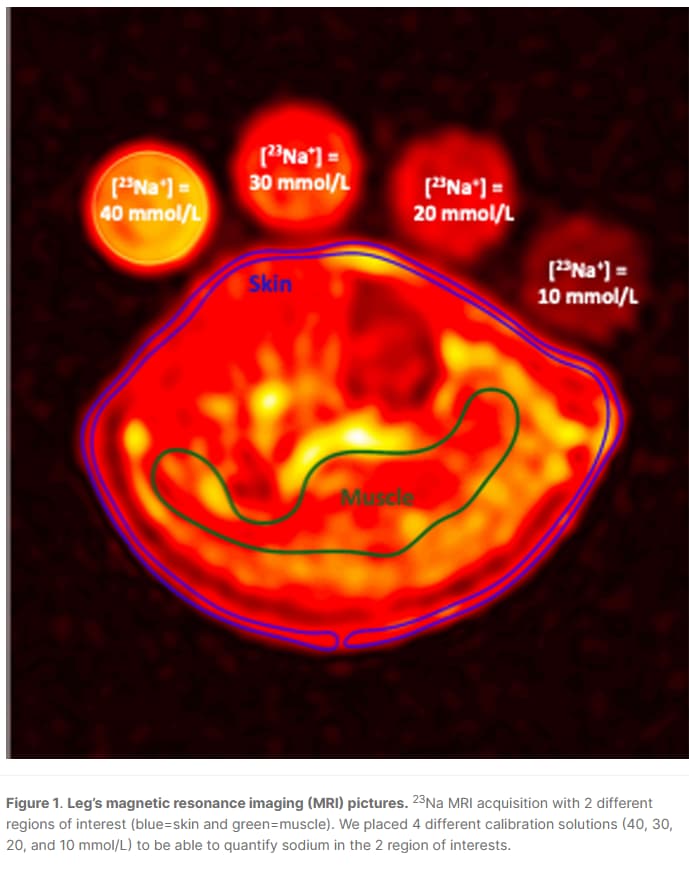
This study has some inherent limitations. First, we were not able to assess clinical impact of salt removal, especially the relationship between skin sodium storage and direct myocardial effect. Moreover, we did not provide causalities or correlation with mortality. We reported in this present study a preliminary exploratory study on tissue sodium storage and emphasized what 23NaMRI could offer to clinical care of HF patients. We would need to increase the number of sampled patients to reach a higher level of certainty. A longitudinal study would be also needed to assess impact of skin sodium storage on cardiovascular events in a future study.
In conclusion, excessive nonosmotically active tissue sodium storage seems to be a characteristic feature of severe HF, over and above any associated renal impairment. Evolving appreciation of the direct toxic consequences of tissue sodium (including myocardial deposition and cardiac fibrosis), developing access to pharmacological and direct dialytic sodium removal strategies highlight the importance of sodium homeostasis in HF and the potential role for 23NaMRI in the management of large and challenging group of patients with HF.
https://www.ahajournals.org/doi/full/10.1161/CIRCIMAGING.121.012910
SODIUM MRI
Recently, we used 23Na-MRI in AD patients on a ultra-high-field (7 T) MR scanner, and were able to show sodium increases in several brain regions, associated with tau-pathology assessed by Flortaucipir-PET imaging in AD (Haeger et al., 2021).
A total of 86 subjects, comprising 52 patients with AD (20 female, mean age 70.4 ± 6.1 years), 20 age-matched elderly control subjects (4 female, mean age 67.8 ± 9.4 years) as well as 14 younger control subjects for analysis of age-related effects (5 female, mean age 29.2 ± 6.4 years) participated in the study.
Interestingly, TSC [Tissue Sodium Concentration] is strongly age- and volume-driven and is linked to the cognitive decline of patients. TSC might therefore serve as a potential marker of cellular energy depletion and disturbed homeostasis, associated with the different states of cognitive decline. TSC could therefore be useful in clinical trials for the evaluation of intervention effects, with a potential metabolic focus.
https://www.sciencedirect.com/science/article/pii/S2213158222003394
Prehistoric man was characteristically exposed to very low levels of dietary sodium—typically with 20 times higher potassium than sodium in their urine (sodium/potassium ratio 0.02); life expectancy reached 70 years and modern day non-communicable diseases such as heart attacks and strokes were almost absent [2]. In stark contrast, we can find urinary sodium/potassium ratios of 10 (healthy < 2.4) in youth with kidney stones [3]. Diseases that used to be described in adults such as hypertension, kidney stones, type II diabetes, metabolic syndrome, and even cardiovascular disease are increasing among adolescents and young adults (AYA) [4,5,6,7]—all potentially linked to increased sodium exposure.
The gap between rich and poor is increasing in developed countries, and in view of the detrimental impact of high salt diet in childhood on longevity and all-cause mortality, we need a call to action.
Too much salt is already a problem since salt worsens the edema of the face, hands, legs, ankles, and feet commonly experienced by the mother during pregnancy. Moreover, high maternal salt intake affects the fetal renal renin angiotensin aldosterone system (RAAS). According to the Dietary Guidelines for Americans established by the Department of Agriculture and the Department of Health and Human Services, the recommendation is up to about a teaspoon of salt a day—that is, 6 g of salt, or approximately 2300 mg of sodium. However, most people living in North America consume more than 3500 mg of sodium per day, including pregnant women
The developmental origins of health and disease theory indicates that many adult-onset diseases originate in the earliest stages of life. The developing kidney is particularly vulnerable to adverse in utero conditions, leading to morphological and functional changes and potentially suboptimal nephron endowment. Malnutrition is the common factor related to hypertension and kidney disease; however, a variety of nutritional insults can cause renal programming including high sucrose and fructose consumption, protein and calorie restriction, and high fat diet [13]. High salt diet during pregnancy needs to be added to this list, at least suggested by data derived from experimental study of female Wistar rats [13, 14]. Oxidative stress, an imbalance between reactive oxygen/nitrogen species and antioxidant systems, plays a pathogenic role in the developmental programming of kidney disease [15]. There is increasing evidence that activation of the RAAS increases oxidative stress. This is important since there is a finite nephron endowment that develops until 36 weeks of gestational age [16].
Healthy children (n = 17) had a median skin sodium concentration of 13.4 (3.3 interquartile range [IQR]), whereas 19 healthy adults had a median skin sodium concentration of 18.7 (6.2 IQR). Similarly, muscleSoleus sodium concentrations were 18.6(1.6 IQR) in children and 22.2 (4.3 IQR) in adults (unpublished results). Sodium concentrations correlated with age.
Tissue sodium has been shown to be mobilized by loop diuretic therapy [27], hemodialysis [28], and the novel sodium glucose cotransporter 2 (SGLT2) inhibitors [29•]. SGLT2 inhibitors are a class of drug widely used in the management of type 2 diabetes mellitus that work by inhibiting the reabsorption of glucose in the proximal convoluted tubule [30]. This class of medications inhibits the coupled reabsorption of sodium and glucose, thereby increasing urinary sodium and glucose wasting. The natriuretic effects coupled with tissue sodium depletion may be one of the main reasons why these medications have such a profound effect on cardiovascular complications [31].
USD is a critical public health concern as it is associated with osteoporosis, the development of CKD, and shortened life-expectancy [42, 43]. A large proportion of USD patients already developed decreased bone mineral density [**44, 45]. Interestingly, this was more prevalent in adolescent males [46], even though females tend to have lower bone mineral density z-scores than males. A major reason for USD is the steady increase in dietary sodium intake in Western countries (typically > 3500 mg/day, whereas the World Health Organization (WHO) recommends < 2000 mg/day) [11, 12, 47, 48]… There is a direct relationship between urinary sodium excretion and urinary calcium wasting [50]. This makes limiting the salt intake the easiest step to reduce the lithogenic risk [
“The sodium intake in the USA for children aged 6–11 years of age increased from 200 mg/day in the 1970s to 3000 mg/day in the 2000s [49]”
This review highlights the relationship between high salt intake and chronic life-limiting conditions such as hypertension, USD, osteoporosis, and CKD in children and AYA as well as the importance of sodium accumulation in the body, measured by 23Na MRI of muscle and skin. The high salt diet in Western societies may be the easiest modifiable factor to curb the growing prevalence of these non-communicable diseases. Obviously, salt wasters must be identified and supplemented accordingly. We exhort the reader to engage in advocacy efforts to curb the incidence and reduce the prevalence of high salt-related life-limiting conditions.
The neurosurgeon who quit and went viral with his 12 M video is down the sodium rabbit hole, IIRC:
- Sodium is stored with collagen in tissues like the muscles, bone, around blood vessels, and so on, as storing sodium in water would be too heavy. It played a vital role in historic past to be able to store sodium.
- In medical school he didn’t learn about this storage, he cites Jens Titze as the one who discovered this relatively recently.
- More sodium storage leads to more visceral or muscle fat but is not stored in it.
- Hunter gatherers eat 700 mg sodium a day
- High sodium does something with the immune system, attacking the body’s own tissues, chronic inflammation.
- A regular sandwich with two slices of bread, pastrami, mozzarella, mayonnaise, and mustard has 900-1000 mg sodium, already over the 700 mg which is for the whole day.
- 1 slice of pizza has 640 mg sodium, nearly the maximum as the hunter-gatherer tribes are doing.
- If you eat the whole pizza, 5000 mg sodium.
- He ate some potato chips, two servings, which was 500 mg sodium and he had eaten his regular food.
- It’s so easy to eat too much sodium.
- When we eat too much, the body stores it away in the skin, etc, and muscles.
- He’s checking content of things like broccoli, sweet potatoes, chickpeas, etc, which all have tens of sodium per serving, some, but not hundreds of mg per serving.
- He believes this is why he observed patients who ate plant-based, whole foods, low sodium, healed the best.
- He said some people heal and do well on carnivore diet, or eat meat, and you can do that he said, but be careful about sodium. A lot of the chicken has salt, brine, injected into the meat.
- Can you be below 700 mg sodium on a carnivore diet? Yes, but it’s harder.
- Need minimum 500 mg a day. AHA recommends maximum 1500 mg. He thinks the healthy amount is between 700 mg - 1500 mg a day of sodium.
- If you’re sweating a lot he said you need more than 700 mg of sodium. You can excrete more by sweating like with sauna, if you eat higher sodium. Sweating can be a hack.
- On long hikes he can bring for example granola bars which total 1000 mg sodium.
- Be careful about hyponatremia, look up symptoms, which can be fatal.
- He noticed during surgery that those who were unhealthy and had DID (degenerative disc disease) had really thick skin, and there were some odd, and a lot of water during surgery, and a lot of fat inside the muscles, and this is all either sodium storage or caused by it.
Literally no one is talking about this new knowledge about sodium storage. This seems way worse than microplastic based on current information @AlexKChen
Unusually I supplement with grams of sodium each day and my own personal test results are not consistent with this.
We know consuming too much salt raises blood pressure, which in turn can lead to cardiovascular problems. A 2022 study has quantified this relationship as a public health message in clear, stark terms.
Looking at health data on adults in China, the study authors estimate that a reduction of just 1 gram in daily salt intake would be enough to prevent 9 million cases of stroke and heart attack between now and 2030.
With 4 million of those cases likely to be fatal, such a simple measure could save a lot of lives
Salt discussion starts at the 39 minute mark. It’s probably nothing new for those of us actively following this thread but I still really enjoy listening to this guy’s perspective.
Good video.
A Cumulative Sodium Hypothesis of Aging is an interesting idea, not mentioned in the video. I wonder if the mice who were given less water in the study at the start of the thread had more sodium stores.
I wonder what SGLT2 / SGLT1 inhibitors does to sodium stores (SODIUM STORES in muscles, collagen, skin, etc, IS A NEW FACT).
I’ve wondered that as well. I’m also curious if and/or to what extent we tap into our sodium stores when we are eating no added salt. I went all summer exercising and sweating outside
eating between 180-400mg per day without any issues whatsoever. It seems the longer I’m consistently eating this way the better I feel and the better my skin looks. It’s definitely a slow process and getting salted throws me off for about 3 days with water retention and dizziness. I really wish we had more information on salt and how it impacts different groups of people. It is actually kind of crazy that something so ubiquitous is virtually ignored.
By people yes, but not scientists, every medical agency in the world recommends reduced sodium consumption. They are using the best science available. They are saying what you are doing is HEALTHY. People think it’s the guidelines that are wrong that’s why people are so unhealthy; it’s because no one follows the guidelines. Salt is needed for the processed food and restaurant industry.
I can only speculate why: We are used to it and we want to eat it. We don’t trust government / medical agencies. Most people at least what they know don’t notice anything from it.
Key facts
- Almost all populations are consuming too much sodium.
- The global mean intake of adults is 4310 mg/day sodium (equivalent to 10.78 g/day salt) (1). This is more than double the World Health Organization recommendation for adults of less than 2000 mg/day sodium (equivalent to < 5 g/day salt).
- The primary health effect associated with diets high in sodium is raised blood pressure, increasing the risk of cardiovascular diseases, gastric cancer, obesity, osteoporosis, Meniere’s disease, and kidney disease.
- An estimated 1.89 million deaths each year are associated with consuming too much sodium (2).
- Reducing sodium intake is one of the most cost-effective measures to improve health and reduce the burden of non-communicable diseases: for every US$ 1 invested in scaling up sodium reduction interventions, there will be a return of at least US$ 12.
If the best science available is pointing to somewhere and medical agencies say “reduce consumption” that means there might be a signal for something terrible at even lower levels.
Since the heart is a muscle I wonder about SODIUM STORES IN THE HEART (SGLT2 inhibitors reduce hospitalizations due to heart failure – speculative connection?)
Stored sodium is not biologically inert and can result in a variety of pathophysiological consequences. Preclinical data suggest that sodium may be directly deposited in myocardium and vascular structures leading to tissue remodeling and inflammation. This is independent from the well-described effects of pressure and volume overload.8,9 The pathophysiological mechanisms concerning sodium producing direct cardiac maladaptive change and injury are currently poorly understood. Clinical data showed increased salt storage is observed in particularly cardiovascular high-risk patients, for example, patients with chronic kidney disease (CKD) and in particular those requiring maintenance dialysis.10,11 (paper I linked earlier https://www.ahajournals.org/doi/full/10.1161/CIRCIMAGING.121.012910)
That’s very helpful @A_User. Thank you. You’re correct that hardly anyone follows those guidelines. I’m not sure where the process is breaking down but it’s not even on most people’s radar at least where I live and nearly impossible to pull off eating the standard western diet.
I have some salt/processed food addicted family members so I think it’s a very hard habit to break for a lot of people. There are also sadly some people that go so far as to reject it simply because the WHO recommends it to their own detriment. I find the WHO recommendations quite generous and personally can’t tolerate even 1/2 of that amount. It’s a poison in the amounts people are consuming that’s hiding in plain sight. Some people even know and can’t stop themselves.
I think everyone knows the food isn’t good for them, including me, but it’s way too hard to stop. It’s not extremely bad as long as people are hydrated. We’d need some replacement like artificial sweeteners are for sugar, although I think salt is much worse than sugar, and drugs that mitigate the problem.
You have to note that people don’t even take their medications when prescribed (i.e like blood pressure meds, or cholesterol lowering meds), so health is low on the agenda even when it’s easy for some reason. Reducing salt is not. Dieting is not either easy for many.
Many of us are going to make it limping to LEV filled with microplastics, salt storages. It’s going to be like a MRI scan and they see a trillion micoplastics and tens of grams salt stored in all of the muscles in the body about to make them pop and explode. The robot doctor is going to output a sigh from its LLM as it wonder in its chain-of-thought why we did this just as the romans used lead pipes, then it sends the nano-bots to clear out the damage.
“I love salt!” - DJT


